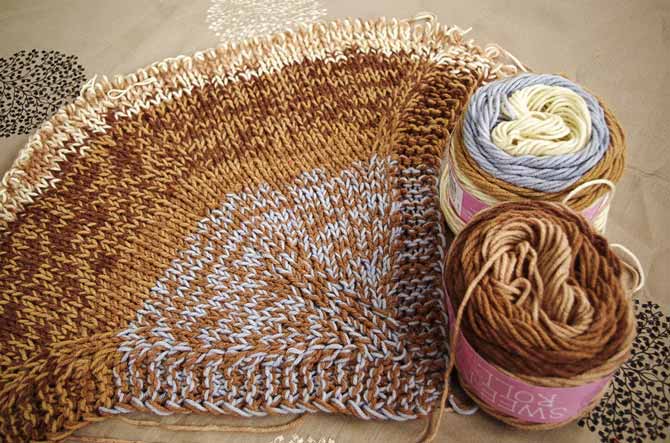This week I’m knitting with Sweet Roll by Premier Yarns. Yesterday, I explored making gradients with this self-striping yarn, and a big swatch. Today I’m sharing a couple of things I learned from swatching that have nothing to do with gauge.

This swatch gave me practice with paired increases made with yarn-overs and twisted stitches. Both techniques improved with this swatch.
I embarked on a project to knit a mitered square blanket out of Sweet Roll yarn, but I wanted to do it in stockinette stitch instead of the traditional garter stitch. Well, there’s a reason why most mitered squares are done in garter stitch. It has to do with the number of rows versus the number of stitches you get. In garter stitch each ridge is comprised of two rows of knitting and the ratio is almost exactly 1 garter stitch ridge to 1 stitch, which makes squares possible.
In stockinette stitch, the ratio is closer to 4 rows to every 3 stitches, so mitered squares that are decreased or increased at the same rate as garter stitch squares end up looking like diamonds.
I did some math and thought it was right, but I ended up with a shape that reminds me of an awning on a Who-ville house (from Dr. Seuss’ How The Grinch Stole Christmas). Needless to say, this swatch is going to the “frog pond” to be unraveled.
But not all is lost. I learned two other things from my failed attempt.
1) I learned that with chunky yarn, or at least with 2 strands of yarn held double, I don’t like lifted increases. Lifted increases are where you lift a leg of a stitch from one or more rows below the current row and knit into it to create a new stitch. For a right-leaning increase you work into the first leg of the stitch one row below the loop on the left-hand needle. For a left-leaning increase, you work into the second leg of the stitch two rows below the loop just knit onto the right-hand needle.
I decided to do twisted yarn over increases:

I shine a light on the twisted yarn-over paired increases.
Twisted yarn over increases are made by adding yarn overs on the right-side rows and purling into the yarn-overs on the wrong-side and twisting the yarn over stitch. To do this, knit to where you want the first of a paired increase to be, yarn-over, knit to where the next increase is to be, yarn-over, and continue. On the return row, at the first yarn-over, change the orientation of the loop on the left-hand needle (if necessary) so that the first leg is at the front and the second leg is at the back, then purl into the back leg. Purl to the next yarn-over and change the orientation of the loop on the left-hand needle (if necessary) so that the first leg is at the back of the needle and the second leg is at the front, then purl into the front leg. These two different maneuvers twist the stitch in opposite directions, which mirrors the increases to give a balanced look.

Right-leaning mix twisted stitches lay the knit stitch over top of the garter stitch ridge.
2) I learned I like the look of twisted stitches where the garter stitch edging butts up against the stockinette section. To make the twist, I used the last garter stitch and the first stockinette stitch to make the twist, which makes the stockinette st cross over the garter stitch bump. To do this on a practice swatch of your own, try the following.

These left-leaning twisted stitches create a unique transition between stockinette and garter stitch panels.
Swatch instructions
Cast on 20 sts.
Rows 1- 6: Knit.
Row 7: Knit.
Row 8: K4, P12, K4.
Row 9: K3, with RH needle lift the left front leg of 2nd st on LH needle and tug open, remove RH and reinsert as if to knit and K1, then slip first st on LH needle purlwise, removing both stitches from LH needle, k10, remove first st off LH needle and pinch with fingers from left hand, slip next st on LH needle purlwise, return pinched loop to LH needle and knit it, K3.
Row 10: K4, P12, K4.
Repeat Rows 9 and 10 for the pattern to desired length.
Knit 6 rows, bind off purlwise.
Let me know if you try the scarf from Wednesday’s post, or either of my discoveries from today. I do hope you try Sweet Roll yarn and that you’ll share with us what you knit with it.
This is part 5 of 5 in this series.
Go back to part 4: Knitting gradients with self-striping yarn
